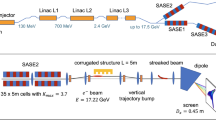Abstract
Besides the original seeded undulator line, in the soft X-ray free-electron laser (SXFEL) user facility in Shanghai, a second undulator line based on self-amplified spontaneous emission is proposed to achieve 2-nm laser pulse with extremely high brightness. In this paper, the beam energy deviation induced by the undulator wakefields is numerically calculated, and 3D and 2D results agree well with each other. The beam energy loss along the undulator degrades the expected FEL output performances, i.e., the pulse energy, radiation power and spectrum, which can be compensated with a proper taper in the undulator. Using the planned time-resolved diagnostic, a novel experiment is proposed to measure the SXFEL longitudinal wakefields.









Similar content being viewed by others
References
W.A. Barletta, J. Bisognano, J.N. Corlett et al., Free electron lasers: present status and future challenges. Nucl. Instrum. Methods Phys. Res. A 618, 69–96 (2010). doi:10.1016/j.nima.2010.02.274
H. Öström, H. Öberg, H. Xin et al., Probing the transition state region in catalytic CO oxidation on Ru. Science 347, 978–982 (2015). doi:10.1126/science.1261747
P. Emma, R. Akre, J. Arthur et al., First lasing and operation of an ångstrom-wavelength free-electron laser. Nat. Photonics 4, 641–647 (2010). doi:10.1038/nphoton.2010.176
T. Ishikawa, H. Aoyagi, T. Asaka et al., A compact X-ray free-electron laser emitting in the sub-ångström region. Nat. Photonics 6, 540–544 (2012). doi:10.1038/nphoton.2012.141
W. Ackermann, G. Asova, V. Ayvazyan et al., Operation of a free-electron laser from the extreme ultraviolet to the water window. Nat. Photonics 1, 336–342 (2007). doi:10.1038/nphoton.2007.76
Shanghai soft X-ray free-electron laser test facility conceptual design report. Shanghai Institute of Applied Physics, Chinese Academy of Sciences, Shanghai (2015)
L.H. Yu, Generation of intense UV radiation by subharmonically seeded single-pass free-electron lasers. Phys. Rev. A 44, 5178–5193 (1991). doi:10.1103/PhysRevA.44.5178
G. Stupakov, Beam echo effect for generation of short-wavelength radiation. Phys. Rev. Lett. 102, 074801 (2009). doi:10.1103/PhysRevLett.102.074801
A. Kondratenko, E. Saldin, Generation of coherent radiation by a relativistic-electron beam in an undulator. Part. Accel. 10, 207–216 (1980)
M. Song, K. Li, C. Feng et al., Wakefield issue and its impact on X-ray photon pulse in the SXFEL test facility. Nucl. Instrum. Methods Phys. Res. A 822, 71–76 (2015). doi:10.1016/j.nima.2016.03.089
M. Song, H. Deng, C. Feng et al., Longitudinal wakefields in the undulator section of SXFEL user facility, in Proceedings of IPAC16, Busan, Korea, MOPOR005, pp. 595–597
A. Lutman, Impact of the wakefields and of an initial energy curvature on a Free Electron Laser. Ph.D. thesis, Università Degli Studi Di Trieste (2010)
P. Craievich, Short-range longitudinal and transverse wakefield effects in FERMI@Elettra FEL project. Ph.D. thesis, Technische Universiteit Eindhoven (2010)
FERMI@ElettraConcept Design Report, Trieste (2007)
I. Zagorodnov, T. Weiland, The short-range transverse Wakefields in Tesla accelerating structure, in Proceedings of PAC03, Portland, Oregon, USA, RPPG034, pp. 3249–3251
T.Y. Lee, H.S. Kang, J. Choi, Study of PAL-XFEL wake field effects with the GENESIS code, in Proceedings of FEL05, Stanford, California, USA, THPP024, pp. 502–505
T. Tanaka, S. Goto, T. Hara et al., Undulator commissioning by characterization of radiation in X-ray free electron lasers. Phys. Rev. Spec. Top. Accel. Beams 15, 110701 (2012). doi:10.1103/PhysRevSTAB.15.110701
K. Bane, I. Zagorodov, Wakefields in the LCLS Undulator Transitions, in Proceedings of EPAC06, Edinburgh, Scotland, THPCH072, pp. 2952–2954
CST-computer simulation technology. http://www.cst.de/
ABCI Home Page. http://abci.kek.jp/abci.htm
M. Borland, Elegant: a flexible SDDS-compliant code for accelerator simulation. Adv. Photon Source LS-287 (2000)
R. Akre, L. Bentson, P. Emma et al., A transverse RF deflecting structure for bunch length and phase space diagnostics, in Proceedings of PAC01, Chicago, IL, USA, WPAH116, pp. 2353–2355
Y. Ding, F.J. Decker, V.A. Dolgashev et al., Results from the LCLS X-Band transverse deflector with femtosecond temporal resolution (SLAC National Accelerator Laboratory, USA, SLAC-PUB-16015, 2014)
K. Bane, G. Stupakov, Using surface impedance for calculating wakefields in flat geometry. Phys. Rev. Spec. Top. Accel. Beams 18, 034401 (2015). doi:10.1103/PhysRevSTAB.18.034401
K. Bane, G. Stupakov, Roughness tolerance studies for the undulator beam pipe chamber of LCLS-II (SLAC National Accelerator Laboratory, USA, SLAC-PUB-15951, 2014)
G. Stupakov, Surface roughness impedance. AIP Conf. Proc. 581, 141–152 (2001). doi:10.1063/1.1401569
G. Stupakov, R.E. Thomson, D. Walz et al., Effects of beam-tube roughness on X-ray free electron laser performance. Phys. Rev. Spec. Top. Accel. Beams 2, 060701 (1999). doi:10.1103/PhysRevSTAB.2.060701
G. Stupakov, Impedance of small obstacles and rough surfaces. Phys. Rev. Spec. Top. Accel. Beams 1, 064401 (1998). doi:10.1103/PhysRevSTAB.1.064401
I. Zagorodnov, Indirect methods for wake potential integration. Phys. Rev. Spec. Top. Accel. Beams 9, 102002 (2006). doi:10.1103/PhysRevSTAB.9.102002
W.M. Fawley, Z. Huang, K.J. Kim et al., Tapered undulators for SASE FELs. Nucl. Instrum. Methods Phys. Res. A 483, 537–541 (2002). doi:10.1016/S0168-9002(02)00377-7
Y. Jiao, J. Wu, Y. Cai et al., Modeling and multidimensional optimization of a tapered free electron laser. Phys. Rev. Spec. Top. Accel. Beams 15, 050704 (2012). doi:10.1103/PhysRevSTAB.15.050704
M. Song, H. Deng, B. Liu et al., Deflecting cavity considerations for time-resolved machine studies of SXFEL user facility, in Proceedings of IBIC16, Barcelona, Spain, MOPG50, pp. 169–172
Acknowledgements
The authors are grateful to Xiao Hu, Wei Zhang, Meng Zhang, Kai Li and Han Zhang for helpful discussions and useful comments.
Author information
Authors and Affiliations
Corresponding author
Additional information
This work was supported by the National Natural Science Foundation of China (Nos. 11475250 and 11322550) and Ten Thousand Talent Program.
Rights and permissions
About this article
Cite this article
Song, MH., Feng, C., Huang, DZ. et al. Wakefields studies for the SXFEL user facility. NUCL SCI TECH 28, 90 (2017). https://doi.org/10.1007/s41365-017-0242-7
Received:
Revised:
Accepted:
Published:
DOI: https://doi.org/10.1007/s41365-017-0242-7




